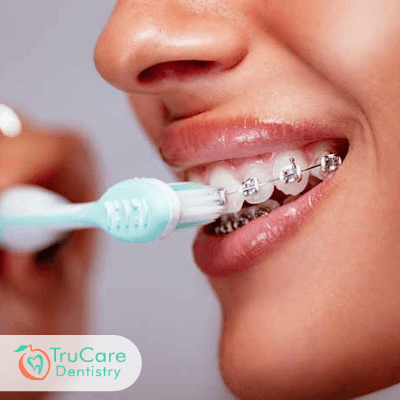Besides straightening teeth, the orthodontic treatment also results in a bright, beautiful smile after the treatment. However, if you skip proper care while you have braces, you may end up with unsatisfactory treatment results. Instead of getting a new smile after removing an Invisalign tray or orthodontic appliance, patients end up with stained teeth.
Metal braces with ceramic brackets need care
Ceramic braces, fixtures face discoloration and turn yellow over time due to exposure to red wine, coffee, tea, and colas. On the other hand, metal braces, wires do not face such an issue. But, ceramic brackets attached to traditional braces do need attention. Plus, elastic bands connecting the archwire with brackets can stain, resulting in visible spots on the dental appliance. Plaque accumulation around the borders of brackets can result in white spots on teeth. If left untreated, the acid released by plaque can also trigger demineralization. Put simply, stains can cause problems for all types of braces.
Staining issues with Invisalign based treatment
Yes, even patients using Invisalign treatment aligners can face tooth staining if they fail to take proper care.
No doubt, removable orthodontic aligners do isolate teeth from the mouth by acting as a barrier. However, one must remember that an aligner is not a waterproof seal. Dark beverages, including coffee, may find a way to reach the teeth.
Beverages or foods that have an intense coloration can result in aligner discoloration. Prolonged exposure to such items can worsen the aligner staining. Aligners turn yellow during the initial stages and slowly change the shade to brown due to constant tea and coffee exposure. Thus, frequently sipping tea, coffee, red wine, or even cola can prove to be bad. And remember, dark beverages can cause more damage than lighter ones.
Stains on dental attachments
Dental attachments, including Invisalign ones, used as a part of orthodontic procedures are made from dental composite material, which is also used as filling for cavities. The material is resistant to staining. However, attachments may end up with stains in some cases. Minimizing the exposure of these dental fittings to dark beverages is the best option.
Dental care professionals clean the accumulated debris around the attachment in case of surface staining. They may also remove and polish these fixtures if required. Dentists avoid extensive polishing attachments as doing the same can result in slight changes (alteration) in their shape, making them useless to work with existing aligners.
Discoloration of dental fixtures is not considered a severe issue because such fixtures remain on the teeth only for a short period.
Patients undergoing almost every type of orthodontic procedure face the risk. Here’re ways to avoid staining while undergoing braces or Invisalign based treatment.
1. Diet consisting of food items that do not result in stains on teeth
Patients can avoid trouble by merely ensuring their diet does not contain anything that can result in stains on teeth or dental attachments. It is crucial not to consume vibrantly colored juices, soft drinks, wine, coffee, tea, and darkly colored sauces. The list of items to be avoided also includes curry, mustard, barbeque, and tomato sauces.
Put simply, even while wearing Invisalign or other braces, patients must avoid foods that have a notorious reputation of causing stains. Remember, if the food item can stain our shirt, it can also do the same to your tooth aligner. If, due to some reasons, you cannot avoid eating these items, you should at least consider brushing your teeth after the meal.
2. Use fluoride-based toothpaste and mouthwash
Dentists recommend patients to opt for mouthwash and toothpaste that contains fluoride. Rinsing with fluoride-based mouthwash is highly recommended for people with braces and aligners. Doing so can help in preventing demineralization and the formation of white spots.
3. Don’t consider whitening when you have braces
People often think they can get an even better smile after getting their braces off if they whiten their teeth a few months before the end of orthodontic treatment. This is a bad idea as the whitening toothpaste, bleach, or gel won’t reach the parts of teeth that remain below braces brackets or Invisalign attachments. Patients may end up with spots on parts of teeth below these attachments when trays or braces are taken off. No one wants teeth with multiple shades of white. Thus, using whitening products while under orthodontic treatment is a strict no!
4. Regular cleaning
No matter if you are under orthodontic treatment or not. Brushing and flossing consistently is crucial for maintaining color and smile.
Following routine oral hygiene habits can be challenging for individuals who have traditional braces. It’s comparatively easy for patients with Invisalign trays as they can remove the device while brushing.
Regular brushing can help in preventing stain-causing pigments and plaque buildup on teeth and dental attachments. Orthodontists also recommend special flossers to assist in cleaning around brackets and other appliances.
5. Do not skip scheduled cleaning sessions
There are areas around aligners, braces, or other dental fixtures where the brush cannot reach. A skilled hygienist at the dental office uses specially designed tools to remove stains, stain-causing pigments, and plaque. Most dentists plan such cleaning sessions twice a year to ensure the patient does not end up with discolored teeth during various orthodontic treatments.
Expect the unexpected
The level of aligner staining varies from one individual to another, depending on his or her food and beverage consumption habits. Staining will be out of the question for patients who can set a brushing routine and remove aligners each time before consuming food or water.Are you looking for Invisalign Braces in Roswell, GA? You should consider fixing an appointment at TruCare Dentistry. The dental office follows all the safety guidelines to protect staff and patients from COVID-19.

